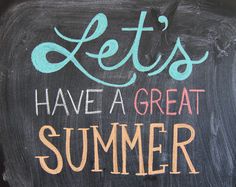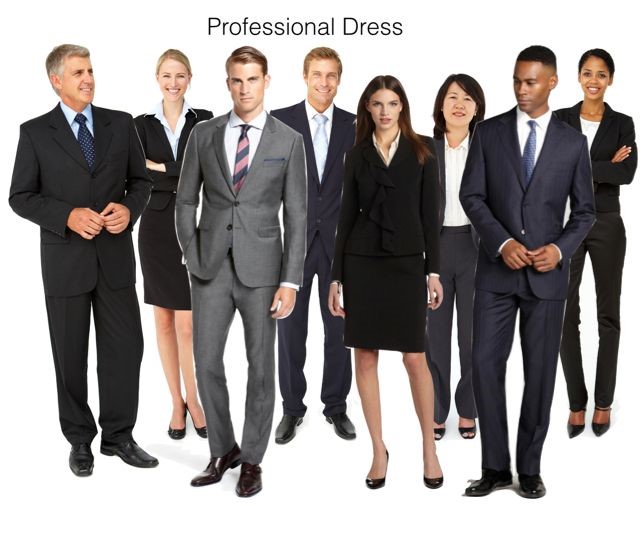
Interview Attire
Business Professional attire involves a “work uniform.” It signals to those around you that you fit, know the rules and their importance, are focused on the work, and will avoid unnecessary risks or time spent on individuality. As such, when interviewing with a law firm, present yourself in the most conservative type of business wear. Women are expected to wear a traditional dark suit with a skirt, pant suit, or dress and jacket. Men are expected to wear a classic silk tie with a traditional dark suit, or blazer and dress pants.
Color matters. Cut matters. Cleaned and pressed matters. All the details matter. The upside is that the essential details also are known, thoroughly well-documented, and presented below. If you have more specific questions, e.g., business professional hairstyles for naturally wavy hair, please check with Google, and verify with the Career Center.

The Dark Business Suit
Invest in a solid suit (matching top and bottom) that is versatile and fits you well, ideally in wool or a wool blend. Black, navy, and charcoal gray are safe color choices. Browns and other grays also are acceptable but are considered less formal. Minimize patterns; a muted pinstripe or herringbone-weave texture can look sharp and go the distance, but a solid color is preferred.
Neutral Colors
As a general rule, interview in neutral colors. The total color palette should be comprised of: black, navy, gray, brown, white, ivory, light blue, light pink, and burgundy. You may share my love for fire-engine red and mustard yellow, but even a pop of these colors can dress down your whole look.
Skirts
For women, a skirt (or suit-dress with matching jacket) is considered more conservative than pants. Women should wear a straight suit skirt or pencil skirt, as more flowing options are considered casual. Make sure that the garment fits you well, has a standing length within two inches of knee-length, and covers your thighs when you sit. To that end, please keep in mind that a slit designed strictly to facilitate traveling and stair-climbing is appropriate; accordingly, a traditional slit in back is fine; a slit in front is not.
Pants
For both men and women, trousers should be hemmed to about 1/2 to 2/3 of the way down your shoe, allowing for a slight fold. Your tailor will know this as a “medium break.” At this length, your socks will show when you walk or sit but not when you are standing still. Women will need to adjust for the height of the shoes they intend to wear (typically 1-2 inch heel). Additionally, women’s business professional pants are straight-leg and are often sold as “trousers.” Leggings or legging-like pants are not suitable for business attire.
Jackets
Make sure that your jacket matches your pants, not only in color, but also in style, and that it fits you well. If you are wearing a long-sleeved shirt underneath, your jacket sleeve should hit your wrist such that your shirt sleeve should peek out just a bit.
Shirts
For men, a white shirt in cotton or a cotton blend is considered standard business attire; blue shirts are also appropriate but are considered slightly less formal. The fit should not be tight. Women have more options as to color and modest patterns but should keep in mind that plunging or lacy necklines have no place in an interview or professional networking setting. Keep it covered.
Simple Jewelry / Belts / Ties / Accessories
Accessories should be simple and conservative, i.e., a necklace and stud earrings for women; a tie, belt, and watch for men. Ties should be classic silk in a stripe or repeating pattern with no more than three colors. Belt color should match shoe color. Facial piercings should be left unadorned and covered, if possible. Women should wear one set of earrings; men should wear none. Avoid bracelets that could steal attention away from the interview, and keep rings to a one-per-hand maximum. Tattoos should be kept covered.
Cosmetics
Makeup should be natural-looking and polished. It should enhance, not change, your appearance and minimize blemishes. Nails should be clean and well-groomed to a good length for typing. Avoid extremes of nail length and color, i.e., no unnatural polish colors, including white, black, blues, grays, and greens.
Shoes
Choose a traditional leather shoe in a color coordinating with your suit, i.e., black, navy, burgundy, or beige/taupe for women. Ensure that they are clean, shined, and in excellent repair. For the most conservative look, keep your toes covered. Avoid excessive straps and spikey heels. Make sure you can walk in your shoes comfortably, quietly, and with confidence. The day of your interview should not be the first time you have worn these shoes recently.
Hose / Socks
Women wondering whether to wear hose should know that there no longer exists a general rule on point. Factors to consider include weather (i.e., how hot/cold will it be), formality of the venue (e.g., hotel, office, etc.), how conservative is the employer, and how will the fit/comfort of your shoes be affected. If you do decide to wear hose, match either the color of your skin or the color of your suit. Socks for men should be over-the-calf and the same solid color as your pants. No crazy socks.

Underclothing
Should not be exposed. At all. Ever.
Hair / Beards
Your hair should be neat, clean, and well-behaved. It should look as professional and serious as you are. Your legal job search season is not the time for adventurous hair. Long hair on women should be kept under control. Men’s hair should be worn in a short and conservative style. With wavy or naturally curly hair, you will need to show that you are a pro at controlling the frizz and volume. If it is long or a bit messy, cut it; it will grow back after you have a job! If you have a beard or mustache, you are not required to shave it off, but you do need to know that it makes your look slightly more casual, and you may need to make the rest of your attire more formal to compensate. Please keep in mind that, for all the time and money you have invested in your professional legal education and job search, not to mention the lifetime of effort you have devoted to getting here, your blue/bleached/cranberry/Mohawk adventure should not be allowed to cost you a solid launch to your career.
Purse / Bag
If you carry a purse, keep it small and simple, or carry a briefcase or business tote in place of a purse. Bag color should coordinate with your shoes, if possible. Backpacks, even trendy laptop backpacks, do not come along to the interview. Consider placing all documents in an interview portfolio, and carry keys, phone, and a slim wallet in your inner jacket pockets. Portfolio – Bring your materials Bring extra copies of: • Resume (up-to-date, printed on resume paper) • Writing sample • Transcript • References Scheduling multiple interviews Ensure that you have plenty of time for transportation from one interview to the other. If all of your interviews will take place in one venue, obtain your schedule at least a day before your interviews. Plan your routes, and take the time to locate restrooms and water fountains. If you have any interviews that are back-to-back, speak with a job-fair coordinator who would be willing to let your next interviewer know if your first interview in the series runs long.
Portfolio – Bring your materials
Bring extra copies of:
• Resume (up-to-date, printed on resume paper)
• Writing sample
• Transcript
• References
Scheduling multiple interviews
Ensure that you have plenty of time for transportation from one interview to the other. If all of your interviews will take place in one venue, obtain your schedule at least a day before your interviews. Plan your routes, and take the time to locate restrooms and water fountains. If you have any interviews that are back-to-back, speak with a job-fair coordinator who would be willing to let your next interviewer know if your first interview in the series runs long.
